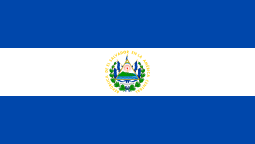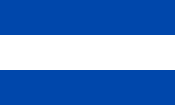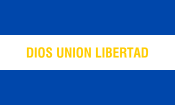Flag of El Salvador
 | |
| Use | State and war flag, naval ensign |
|---|---|
| Proportion | 189:335 |
| Adopted | May 27, 1912 |
| Design | A horizontal triband of blue (top and bottom) and white with the National Coat of Arms centered on the white band. |
 | |
| Use | Civil flag |
| Proportion | 3:5 |
 | |
| Use | State and war flag, civil and state ensign |
| Proportion | 3:5 |
The flag of El Salvador was inspired by the flag of the Federal Republic of Central America, and by the flag of Argentina, the country that sent one of the first fleets to help consummate the independence of Central American republics from Spain.
Features
There are two versions of the flag, one containing the national coat of arms with the words REPUBLICA DE EL SALVADOR EN LA AMERICA CENTRAL (Spanish: Republic of El Salvador in Central America), and the other with the words DIOS UNION LIBERTAD (Spanish: God, Union, Liberty); both have the words in amber. The one bearing the coat of arms is used by the government and state organizations. The other version is used for civil purposes. Both contain the same lustrous vivid vibrant cobalt blue and white stripes and both flags have a 3:5 aspect ratio.
From 1865 to 1912, a different flag was in use, with a field of alternating cobalt blue and white stripes and a red canton containing white stars. The designs of both sides of the flag are different; at the reverse side, it shows the then national coat of arms at the position of stars at obverse. The stars symbolized the provinces of the Republic; once a new province was created, one star was add to the obverse of the flag. This "Star-Striped" banner were considered to be inspired from flag of the United States.
The actual cobalt blue and white stripes in the flag are based on the importance of añil exports—añil was commonly used as a source for indigo dye.
-
Feb. 20, 1822 - Feb. 10, 1823, 1841 - 1842, 1844 - May 9, 1865 (as part of United Provinces of Central America) (civil flag)
-
Aug. 21, 1823 - 1824, 1842 - 1844 (as part of United Provinces of Central America)
-
1824 - 1841,1921 - 1922 (as part of Federal Republic of Central America)
-
May 9 - June, 1865
-
June, 1865 - 1869
-
1869 - 1873
-
1873 - 1877
-
1877 - May 17, 1912
-
Nov. 2 - Nov. 30, 1898 (as part of Greater Republic of Central America)
-
Flag of El Salvador (1865-1877)(Reverse side)
-
Flag of El Salvador (1877-1912)(Reverse side)











